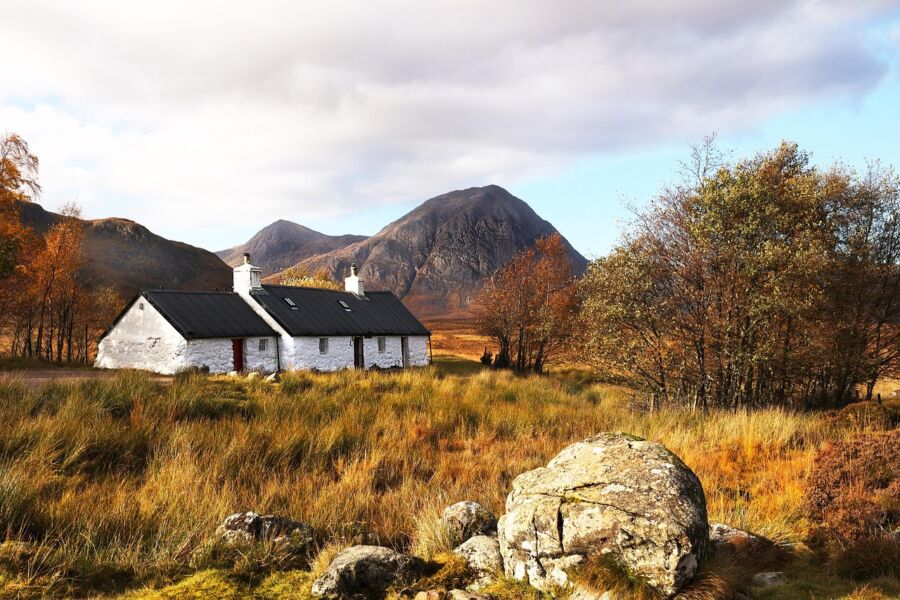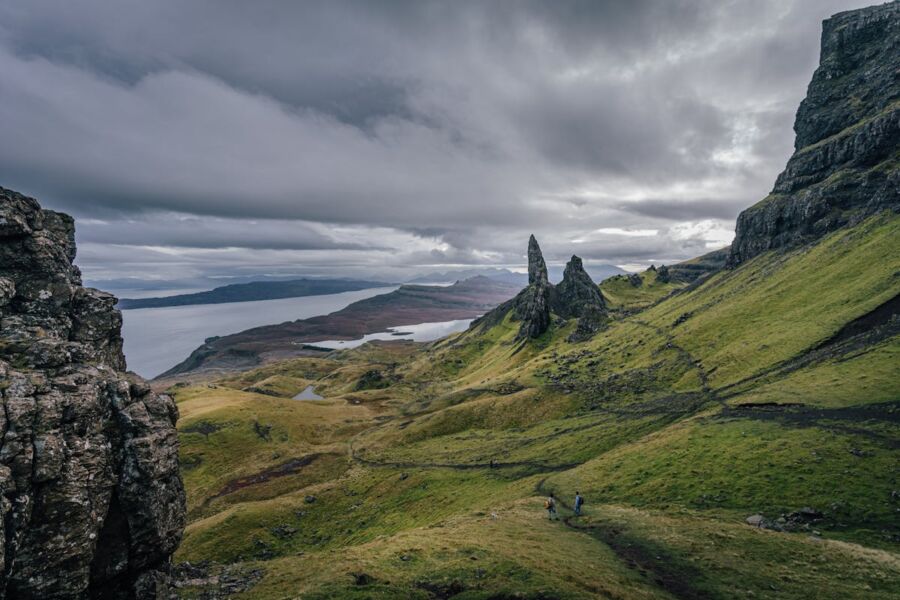
Scotland Trip Cost: 7 Days Under £1000, Dream Highland Adventure
Planning a trip to Scotland? You’re in for a treat! This beautiful country offers stunning landscapes, rich history, and warm hospitality. But you might be wondering: how much will it cost? Two people typically spend $5,000 to $6,600 on a 7-day trip to Scotland. This breaks down to about $350 to $470 per person, per day.
Don’t let those numbers scare you off! Scotland can be enjoyed on many budgets. You can slash costs by camping, cooking your own meals, and focusing on free activities like hiking. Or you can splurge on luxury hotels and fine dining. It’s up to you!
Your biggest expenses will be flights, lodging, and food. Flights from the U.S. to Scotland often cost around $1,000 per person. Hotels average $114 per night, but you can find cheaper options. Plan to spend about $200 per day on food and activities for two people. With some smart planning, you can have an amazing Scottish adventure without breaking the bank.
Contents
- Planning Your Scotland Trip Budget
- Overview of Travel Costs
- Setting a Budget
- Money-Saving Tips
- Getting to Scotland
- Choosing Flights
- Travel Insurance
- Alternative Travel Options
- Accommodations in Scotland
- Hotels and Hostels
- Vacation Rentals and Camping
- Navigating Around Scotland
- Public Transportation
- Car Rentals and Driving
- Walking and Cycling Options
- Dining and Meals
- Budget-Friendly Eating
- Sightseeing and Attractions
- Must-See Landmarks
- Cultural and Natural Sites
- Organized Tours Vs. Self-Guided
- Activities and Experiences
- Outdoor Adventures
- Cultural Experiences
- Family-Friendly Activities
- Travel Tips and Practical Information
- Weather and Best Time to Visit
- Communication and Connectivity
- Safety and Health Precautions
- More Travel Guides
Planning Your Scotland Trip Budget
Planning a trip to Scotland involves careful budgeting to make the most of your adventure. Let’s break down the costs and explore ways to save money while experiencing all this beautiful country has to offer.
Overview of Travel Costs

A 7-day trip to Scotland for two people typically costs around $6,600. This breaks down to about $378 per person per day. Your biggest expenses will be flights, accommodations, and activities.
Flights to Scotland from the US can range from $600 to $1,500 per person, depending on your departure city and time of year.
Accommodation costs vary widely. You might pay:
- $30-50 per night for hostels
- $100-150 for budget hotels
- $200+ for luxury options
Food costs about $30-50 per person daily if you mix eating out and cooking.
Transportation within Scotland can add $30-50 per day for public transit or car rentals.
Setting a Budget
To set your Scotland trip budget, start by deciding how long you want to stay and what type of experience you’re after. Are you a budget backpacker or looking for luxury?
Make a list of must-see places and activities. Research costs for each and add them up. Don’t forget to include:
- Flights
- Accommodations
- Food and drinks
- Local transportation
- Attractions and tours
- Shopping and souvenirs
Add a buffer of 10-15% for unexpected expenses. This gives you a rough total to start saving towards.
Money-Saving Tips
You can cut costs on your Scotland trip without sacrificing experiences. Here are some tips:
Travel in the off-season (October to April) for cheaper flights and accommodations.
Use travel credit cards to earn points for flights and hotels.
Stay in hostels or rent apartments for longer stays to save on lodging and food costs.
Buy a Historic Scotland Explorer Pass for access to many castles and historic sites.
Take advantage of free attractions like museums and hiking trails.
Use public transportation instead of renting a car in cities.
Eat at local pubs and markets instead of touristy restaurants.
Getting to Scotland

Planning your journey to Scotland involves considering transportation options and travel protection. Flying is often the most convenient choice, but alternatives exist for budget-conscious travelers.
Choosing Flights
When booking flights to Scotland, timing is key. Prices tend to be lower in the off-season from November to March. Look for deals on flight comparison websites to find the best rates. Edinburgh and Glasgow are the main international airports, but consider flying into smaller airports like Aberdeen or Inverness for potential savings.
Try to book your flights 3-4 months in advance for the best prices. Midweek flights are often cheaper than weekend ones. If you’re flexible with dates, use the calendar view to spot the lowest fares.
Remember to factor in baggage fees and seat selection costs when comparing prices. Some budget airlines offer very low base fares but charge extra for everything else.
Travel Insurance
Don’t skip travel insurance for your Scotland trip. It protects you from unexpected costs due to cancellations, delays, or medical issues.
Basic policies start around $50 for a week-long trip. More comprehensive coverage can cost $100-$200 but offers better protection.
Look for policies that cover:
- Trip cancellation and interruption
- Emergency medical expenses
- Lost or delayed baggage
- Flight delays and missed connections
If you plan on hiking or doing other outdoor activities, make sure your policy covers adventure sports. Some credit cards offer travel insurance, so check if you’re already covered before buying a separate policy.
Alternative Travel Options
Flying isn’t your only choice for getting to Scotland. If you’re coming from elsewhere in the UK or Europe, consider these options:
Train: Take the scenic route on rail services like the Caledonian Sleeper from London to Scotland. Book in advance for the best fares.
Ferry: Travel by sea from Northern Ireland or continental Europe. It’s slower but can be a fun experience, especially if you’re bringing a car.
Bus: Budget-friendly but time-consuming. Companies like National Express offer services from major UK cities to Scotland.
Driving: Rent a car or bring your own if you’re already in the UK. It gives you flexibility but remember to factor in fuel costs and potential toll charges.
Each option has pros and cons in terms of cost, comfort, and travel time. Choose based on your budget, schedule, and personal preferences.
Accommodations in Scotland

Scotland offers a range of places to stay for every budget and travel style. From cozy hotels to scenic camping spots, you’ll find options to suit your needs and preferences.
Hotels and Hostels
Booking.com has lots of choices for hotels in Scotland. You can find rooms from £65 to £295 per night. The average price is about £114. In big cities like Edinburgh or Glasgow, expect to pay more. Small towns and rural areas are often cheaper.
Hostels are a great way to save money. You can get a bed in a shared room for £15-30 per night. Many hostels have private rooms too, usually for £40-80. They’re perfect if you want to meet other travelers.
B&Bs are popular in Scotland. They offer a comfy room and home-cooked breakfast. Prices vary but are often £60-100 per night.
Vacation Rentals and Camping
Vacation rentals give you more space and freedom. You can rent a whole apartment or cottage. Prices range from £220 to £440 per night. It’s often cheaper per person if you’re traveling in a group.
Camping is the cheapest option. Many campsites charge £10-20 per night for a tent pitch. You’ll need your own gear, but it’s a great way to enjoy Scotland’s outdoors.
Wild camping is allowed in most of Scotland. It’s free, but make sure you follow the rules. Leave no trace and respect the environment.
Some farms offer “glamping” in yurts or pods. It’s more comfy than regular camping. Prices are usually £50-100 per night.

Getting from place to place in Scotland is easy and fun. You’ve got lots of ways to explore this beautiful country, from trains to rental cars to bike paths.
Public Transportation
Scotland’s public transit system is top-notch. Buses and trains connect most towns and cities. ScotRail runs trains to major destinations like Edinburgh, Glasgow, and Aberdeen. A 7-day rail pass costs about £150-200, letting you hop on and off as you please.
Buses are cheaper but slower. Megabus and National Express offer budget-friendly rides between cities. A Glasgow to Edinburgh bus ticket might set you back £10-15.
In cities, local buses and trams are handy. Edinburgh’s tram runs from the airport to the city center for £6.50 one-way. Glasgow’s subway circles the city center for £4 per day.
Car Rentals and Driving
Renting a car gives you freedom to roam Scotland’s countryside. Expect to pay £30-50 per day for a small car. Remember, Scots drive on the left! Gas (called petrol) costs about £1.30 per liter.
Rural roads can be narrow and winding. Take it slow and watch for sheep! Parking in cities can be pricey, up to £20 a day in Edinburgh.
Cheap Car Rental options are available if you look around. Book early for the best deals, especially in summer.
Walking and Cycling Options
Scotland’s cities are perfect for walking. Edinburgh’s Royal Mile and Glasgow’s Buchanan Street are fun to explore on foot. Many towns offer free walking tours – great for history buffs!
Cycling is popular too. Cities have bike lanes and rental shops. Expect to pay £15-25 per day for a basic bike rental. E-bikes cost more, around £30-40 daily.
For a real adventure, try long-distance walking or cycling routes. The West Highland Way is a famous 96-mile trek. You can do bits of it in a day or tackle the whole thing in a week.
Dining and Meals

Food is a big part of any trip to Scotland. You’ll find plenty of tasty options to suit different budgets and tastes. Let’s look at some wallet-friendly ways to eat well without breaking the bank.
Budget-Friendly Eating
You can save money on food in Scotland by mixing eating out with cooking your own meals. Many hostels and vacation rentals have kitchens you can use. Hit up local grocery stores or markets to grab ingredients for simple breakfasts and picnic lunches.
For cheap eats out, try fish and chip shops, bakeries, or pubs during lunch hours. Lots of pubs offer deals like £5-10 lunch specials. Grabbing a sandwich or pasty to go is another budget-friendly option.
When you do eat at restaurants, lunch is usually cheaper than dinner. Many places have early bird specials or pre-theater menus with good deals if you eat before 6 or 7 PM.
Don’t forget to try some Scottish specialties like haggis, neeps and tatties or a full Scottish breakfast. Even on a budget, you can sample local flavors without spending too much.
Sightseeing and Attractions

Scotland’s rich history and stunning landscapes offer countless opportunities for exploration. From ancient castles to rugged islands, there’s something for every traveler.
Must-See Landmarks
Edinburgh Castle is a top attraction you can’t miss. Perched on a hilltop, it offers breathtaking views of the city. Tickets cost around £18 for adults and £11 for children.
Glasgow Cathedral is another iconic spot. It’s free to enter, but donations are welcome.
For a taste of royalty, visit Stirling Castle. Adult tickets are about £16, while kids pay £9.50.
Don’t forget the Scottish Parliament Building. It’s open to the public and free to visit.
Cultural and Natural Sites
The Orkney Islands are a treasure trove of ancient history. You can book a tour to explore Neolithic sites like Skara Brae. Prices start at £50 per person.
Loch Ness is famous for its mythical monster. Boat tours cost about £15-£30, depending on the length.
The Shetland Islands offer unique wildlife experiences. You might spot puffins or seals. Day trips from mainland Scotland start at £100.
For whisky lovers, distillery tours are a must. Prices range from £10 to £50, often including tastings.
Organized Tours Vs. Self-Guided
Organized tours can save you time and hassle. They often include transport and entrance fees. A full-day tour of the Highlands might cost £50-£100 per person.
Self-guided trips give you more flexibility. You can set your own pace and save money on guide fees.
Public transport can be cheaper than organized tours. A 3-day train pass costs about £150 and lets you explore multiple cities.
Renting a car gives you freedom to visit remote areas. Expect to pay £30-£50 per day, plus fuel costs.
Consider mixing both approaches. You could book activities in advance but leave some days open for spontaneous adventures.
Activities and Experiences

Scotland offers a wealth of unforgettable experiences for every type of traveler. From rugged outdoor adventures to rich cultural heritage, you’ll find plenty to see and do without breaking the bank.
Outdoor Adventures
Lace up your hiking boots and hit the trails in Scotland’s stunning national parks. The West Highland Way is a popular long-distance route with breathtaking scenery. Day hikes cost nothing but your time and energy. For a small fee, you can rent a bike and cycle through picturesque countryside.
Want to get out on the water? Try kayaking or canoeing on Loch Lomond for about £40 per person. Golf enthusiasts can play a round at St Andrews Links starting at £190 in peak season. Budget tip: Look for twilight tee times for lower rates.
Brave souls can try wild swimming in lochs and rivers for free. Just bring a wetsuit – the water’s chilly!
Cultural Experiences
Immerse yourself in Scottish history and culture without spending a fortune. Many museums like the National Museum of Scotland in Edinburgh are free to visit. Explore ancient castles like Stirling Castle for around £16 per adult.
Catch a traditional ceilidh dance for about £10 entry. You’ll have a blast learning Scottish dances and mingling with locals. Whisky fans can tour distilleries starting at £15, often including tastings.
For a splurge, book tickets to the Royal Edinburgh Military Tattoo in August. Prices range from £30 to £340 for the fanciest seats. It’s a spectacular show you won’t forget!
Family-Friendly Activities
Keep the kids entertained without breaking the bank in Scotland. Visit the free Kelvingrove Art Gallery and Museum in Glasgow, with hands-on exhibits for all ages. The Edinburgh Zoo costs about £20 for adults and £12 for kids, with adorable penguins and pandas.
Take a scenic train ride on the Jacobite Steam Train, aka the “Hogwarts Express.” Tickets start at £52 for adults and £30 for kids. Bring your camera for stunning views!
On rainy days, head to Dynamic Earth in Edinburgh. This interactive science center costs £16.50 for adults and £10.50 for kids. You’ll learn about Earth’s history through fun exhibits and a 4D movie.
Travel Tips and Practical Information
Planning a Scotland trip can be tricky. Here are some key things to keep in mind for a smooth and budget-friendly adventure.
Weather and Best Time to Visit
Scotland’s weather is famously unpredictable. Pack layers and a good raincoat no matter when you visit.
Summer (June-August) brings the warmest temps and longest daylight hours, but it’s also peak tourist season with higher prices.
Spring and fall are great compromise seasons. You’ll get milder weather and fewer crowds. May and September are especially nice.
Winter can be cold and dark, but you might catch the Northern Lights in the far north.
Avoid July and August if you’re on a tight budget. Prices skyrocket during the Edinburgh Festival. Consider visiting in April or October for better deals on flights and hotels.
Communication and Connectivity
Most Scots speak English, but the accent can take some getting used to. Don’t be shy about asking folks to repeat themselves.
Wi-Fi is widely available in cities and towns. Many pubs, cafes, and hotels offer free Wi-Fi.
For mobile data, pick up a local SIM card when you arrive. It’s way cheaper than international roaming.
In rural areas, connectivity can be spotty. Download offline maps and info before heading to the Highlands or islands. Bring a portable charger too – all that photo-taking drains your battery fast!
Safety and Health Precautions
Scotland is generally very safe for travelers. Use common sense precautions like you would at home. Watch your belongings in crowded tourist areas and don’t leave valuables visible in your rental car.
The tap water is safe to drink throughout the country. No need to buy bottled water.
If you’re hiking in remote areas, let someone know your plans. The weather can change quickly in the mountains. Bring proper gear and know basic wilderness safety.
Travel insurance is a good idea, especially if you plan on doing any adventure activities. The NHS provides free emergency care to visitors, but you’ll need to pay for non-urgent treatment.



